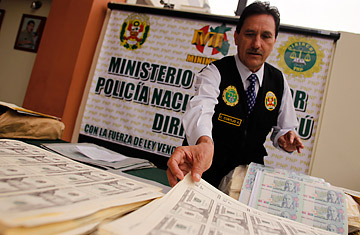
A Peruvian police agent displays counterfeit U.S. dollars during a media conference in Lima on Sept. 8, 2010
Back in the 1980s, Peru's government ran the printing presses as an answer to the country's massive economic crisis, but churning out currency only made things worse, hyperinflation topping off at 1.2 million percent by the end of the decade.
The printing presses have returned, but this time it is not the government cranking out bills, and the currency is not necessarily the Peruvian nuevo sol. Some days it's euros, while others it's Venezuelan bolívares fuertes or Bolivian and Chilean pesos. Most days, however, it's U.S. dollars.
In the past two years, Peru has become the No. 1 distributor of counterfeit currency internationally, according to Kenneth Jenkins, a U.S. special agent in charge of the Secret Service's Criminal Investigative Division. "Approximately $33 million has been seized in Peru since 2009, which is a substantial number," Jenkins told TIME in a telephone interview from Washington.
Officers in the Peruvian police's fraud unit estimate that a much larger sum of phony money is being printed in the country. They say that what has been seized in the past two years represents only a fraction of different bills, including Peruvian currency, being pumped out by clandestine printing presses. "Counterfeit operations have been multiplying for several years now. For every person we arrest, there are probably nine others printing bills," says an officer who by law cannot make his identity known.
The largest single haul so far took place in early September, when police officers raided a printing press in Lima's San Juan de Lurigancho district. While the house had been under surveillance for some time, officers were stunned to discover the extent of the operation. The final tally of the six different currencies produced was just above $27 million. Fake U.S. $100 bills accounted for nearly one-third of the total, while euros accounted for $4 million. The rest of the bills were Bolivian, Chilean, Peruvian and Venezuelan currencies.
A month earlier, agents had run a sting operation that netted $1 million. The drop-off point was the food court at an upscale Lima shopping center built into cliffs overlooking the ocean. The counterfeiters agreed to sell each $100 bill for $5 to an undercover agent. The three people arrested had initially agreed to sell $3 million in fake bills. About 20 illegal printing presses have been dismantled in Lima, each capable of turning out mass amounts of bills.
In the U.S., counterfeiting tends to be small-bore, almost a cottage industry, involving self-starters using digital technology and producing limited quantities of bills at a time. Operations in Peru continue to use traditional printing techniques, with offset printers — the principal tool of the trade — churning out large numbers of scrip. Nearly all of the major busts have occurred in San Juan de Lurigancho, Lima's largest district (with more than 1 million people), where it is easy to set up shop behind a garage door and go unnoticed. (The capital also has a section where small, legitimate printing presses stretch one after another for blocks, but counterfeiters seem to have avoided — or have not been detected in — that downtown zone.) "Overseas operations tend to be more organized than in the United States. They are using printing presses that allow them to print higher volumes," says Jenkins.
In the past few months, Peruvian police have stopped people and parcels with fake U.S. bills heading to Costa Rica, Ecuador, Mexico, Venezuela and, of course, the U.S. Along the way, they have come across a vast array of methods, some quite creative, to get fake bills out of Peru. They have stopped passengers boarding flights to the U.S. with dollars stuffed into their shoes and have routinely found packages filled with freshly made dollars being sent through the local postal service or via international couriers. One raid discovered counterfeit bills sewn into stuffed animals destined for Ecuador, which uses the U.S. dollar as its official currency; another found bills hidden in false bottoms of baby cribs. Those bills were going to Central America. "We have been successful in breaking up several important counterfeit operations, but they are always coming up with new ways to smuggle bills," says a member of the police's fraud unit.
What kind of punishment do counterfeiters face? The law is relatively benign when it comes to the crime. First-time offenders may be sentenced to three years in prison, but it is unlikely for them to end up behind bars. Repeat offenders may get sentences as long as six years, but they can be out in two years thanks to a law that benefits nonviolent offenders. A team of lawyers at the Lima Bar Association has been looking at the issue, working on draft legislation that will be submitted to Congress to change the way counterfeiting is dealt with in the criminal code. "There needs to be more control, and sentences need to be dissuasive. This is not about having lax laws or applying an iron fist but having a penalty that is just and fits the crime," says José Antonio Ñique, president of the Bar Association. "There are great artists in this country, but some of them are using their talents for counterfeiting. Unfortunately for us, they are quite good at what they do."
The U.S. has a task force operating in Peru even though the Secret Service does not have a permanent office in the country. (The closest is in Colombia, which was the counterfeit capital of the world until a joint U.S.-Colombian group helped stanch production.) Jenkins credits the task force and the Peruvian units involved with eliminating a huge chunk of fake cash destined for the U.S. Says Jenkins: "Our ultimate goal is to get the counterfeit plants and seize counterfeit currency before it can leave the country, which is what we have been successfully doing in Peru."
